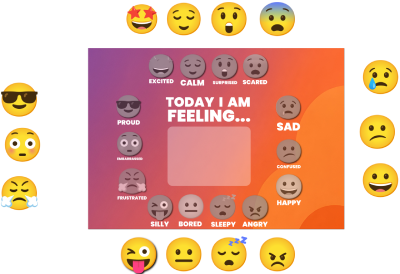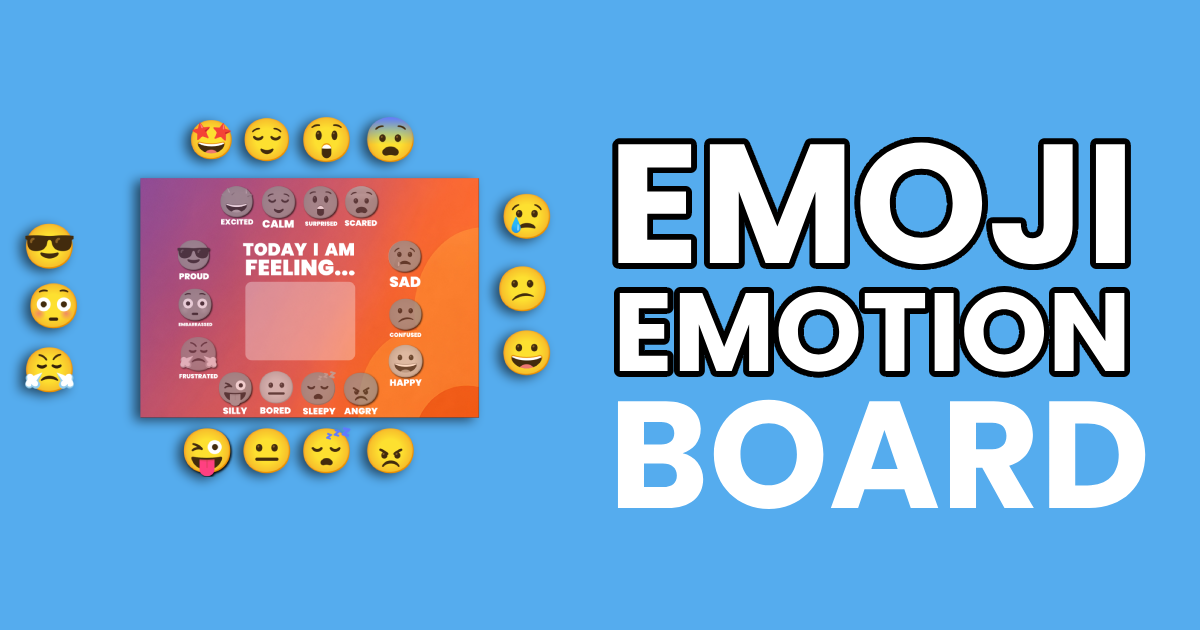Helping children name and express their emotions isn’t just a nice idea — it’s foundational to learning, behaviour, and well-being. This is especially true for neurodivergent children who may experience intense emotions but struggle to communicate them verbally. Traditional “feelings posters” often fall short in real-world classrooms and homes, offering static visuals without interaction or genuine engagement. What children need is a tool that’s intuitive, hands-on, and responsive to their lived experience. That’s where the Printable Emoji Emotion Board from EZC comes in. Designed by someone who works directly with autistic children, it blends visual communication, tactile interaction, and choice-based expression — all wrapped in a format that kids already understand: emoji.
Why Emotional Literacy Matters in Early Education
Emotional literacy is the ability to recognise, understand, and express emotions. For young children — especially those with speech delays, autism, ADHD, or anxiety — this skill can be incredibly difficult to develop. When a child can’t explain how they feel, frustration builds fast, often leading to outbursts, shutdowns, or what adults mistakenly interpret as “bad behaviour.” But what if the child simply lacks the words — or the trust — to say what’s really going on?
Visual tools can bridge that gap. They help children make abstract emotional states concrete. When you give a child a visual vocabulary for their internal experience, you’re not just managing behaviour — you’re cultivating resilience, empathy, and self-awareness.

How the EZC Emotion Board Works
At the heart of this resource is a vibrant, child-friendly board labelled “Today I am feeling…”. Around the edges are sixteen clearly drawn grayscale emojis, each representing a distinct emotional state: happy, sad, frustrated, calm, proud, confused, and more. These aren’t just decorations — they act as “home slots” for matching emoji pieces. Children choose one or two cut-out colour emoji discs, attach velcro to the back, and stick them over the grey versions to reflect how they’re feeling.
This simple process has profound effects. It gives children autonomy over their emotional expression while reinforcing visual matching, emotional vocabulary, and decision-making. The act of selecting and placing the emoji encourages calm reflection. And because the resource supports multiple emotions, it naturally leads to more complex conversations — “You’re feeling both excited and scared?” — that help build a richer understanding of emotional nuance.
Why Emoji Are the Perfect Emotional Symbols
Emoji are far more than internet shorthand — they are powerful symbolic tools that children already understand and use. Unlike generic clipart faces or oversimplified cartoon expressions, emojis are instantly recognisable, emotionally expressive, and culturally embedded. Whether a child is nonverbal, dyslexic, autistic, or simply learning English as a second language, emoji transcend linguistic barriers.
They’re also fun. Children don’t see emoji as instructional or medical. They see them as familiar, friendly, and safe. This emotional board works because it doesn’t look like a behaviour chart. It feels more like a game — one with emotional intelligence built in.
What Makes This Emotion Board Different
This is not another decorative classroom poster. This is a hands-on communication tool designed for daily use in real classrooms and homes. It was created not by a graphic design agency, but by someone who works directly with neurodivergent children and understands the day-to-day struggles they face in expressing themselves. Every element — from the layout to the velcro system to the grayscale placeholders — has been tested and iterated for function, not just aesthetics.
The board allows for multiple simultaneous emotions, because children are rarely just one thing at a time. It’s not limited to “happy” and “sad” — it supports complex, layered emotional states. And it supports tactile learners by inviting physical interaction — choosing, placing, matching — that reinforces emotional awareness through movement.
Who This Emotion Board Is For
The EZC Printable Emoji Emotion Board is ideal for SENCOs, speech and language therapists, primary school teachers, home educators, and parents of neurodivergent children. It’s especially useful in EYFS and Key Stage 1 settings, or anywhere children need support recognising and naming emotions.
But this resource also shines in one-on-one interventions. If you work with children who use PECS or AAC, this board can slot easily into your existing toolkit. It’s compatible with structured environments and open-ended learning alike. It can live on a classroom wall, in a calm corner, or even in a child’s bedroom.
Why Velcro and Greyscale Matching Are Game-Changers
Velcro makes this board tactile, durable, and reusable — children love the sensory feel of pulling and sticking the discs, and it gives them a physical outlet for emotional ownership. The greyscale background images aren’t just placeholders; they teach children to match emotional expressions visually, reinforcing cognitive and spatial processing alongside emotional intelligence.
And when children replace a grey emoji with a full-colour one, something powerful happens: their feelings become visible, seen, and validated. It’s no longer just a “check-in” — it’s a daily emotional ritual.
Get the Free Printable Emotion Board Now
This resource pack includes:
- A full-colour Emotion Board with 16 core emotions
- A greyscale baseboard for placement and matching
- Printable emoji cut-out discs (perfect for velcro)
- Optional usage guide and setup instructions
You can download it now completely free — no account, no gimmicks. Use it with your own children, in the classroom, or in therapy settings. Want to go further? You can also use EZC (Emoji Composer) to create your own custom emotion boards, visual schedules, or communication tools — all from your browser.
About EZC: The Free Tool Behind the Board
EZC is a free, browser-based app that lets you compose emoji layouts, add custom backgrounds, and export high-resolution PNGs for print or digital use. Originally designed to help autistic learners engage with visual symbols in a joyful way, it’s grown into a powerful tool for educators, therapists, and designers alike.
With EZC, you can:
- Create your own emotion boards with different emoji sets
- Add text, shapes, shadows, or icons
- Save and reload projects
- Print at A4 or even A3 sizes
- Export full-bleed PNGs at 300DPI, perfect for laminating
EZC is free to explore and create with — but printing and exporting are premium features available to subscribers. Subscriptions cost just $1/month and help support the ongoing development of educational resources like this one.
Conclusion: A Small Tool That Builds Big Skills
In a world where children are under increasing pressure to behave without ever being taught how to feel, this board offers a simple, effective, and joyful intervention. It doesn’t take much time to use. It doesn’t require specialist training. It just works — because it meets children where they are: curious, emotional, and often overwhelmed.
The EZC Printable Emoji Emotion Board helps children express themselves clearly, calmly, and confidently — one velcro emoji at a time. Whether you’re an exhausted parent, a classroom teacher, or a learning support assistant looking for one tool that will actually make a difference, this is it. Try it today — and give children the language they need to be heard.

